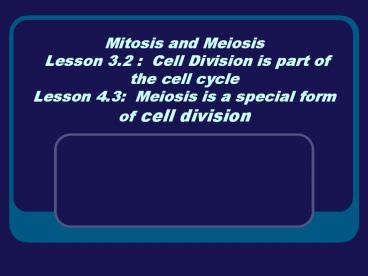Mitosis and Meiosis Lesson 3.2 : Cell Division is part of the cell cycle Lesson 4.3: Meiosis is a special form of cell division - PowerPoint PPT Presentation
1 / 13
Title:
Mitosis and Meiosis Lesson 3.2 : Cell Division is part of the cell cycle Lesson 4.3: Meiosis is a special form of cell division
Description:
Mitosis and Meiosis Lesson 3.2 : Cell Division is part of the cell cycle Lesson 4.3: Meiosis is a special form of cell division 3.2: The cell cycle includes ... – PowerPoint PPT presentation
Number of Views:217
Avg rating:3.0/5.0
Title: Mitosis and Meiosis Lesson 3.2 : Cell Division is part of the cell cycle Lesson 4.3: Meiosis is a special form of cell division
1
Mitosis and Meiosis Lesson 3.2 Cell Division
is part of the cell cycleLesson 4.3 Meiosis is
a special form of cell division
2
3.2 The cell cycle includes interphase and cell
division
- All living things live, grow, reproduce, and die
in a process called a life cycle. - Cell Cycle the normal sequence of development
and division of a cell. - Cell cycle consists of two main phases
interphase mitosis/cytokinesis
3
Interphase
- Part of the cell cycle during which a cell is not
dividing. - The cell grows to about twice the size it was
when first produced. - The cell engages in normal activities
transporting materials in and transporting wastes
out cellular respiration occurs providing energy
to the cell - It duplicates its DNA exactly
4
Cell Division Phase
- Mitosis part of the cell cycle during which the
nucleus divides - Cytokinesis the divison of the parent cells
cytoplasm occurs immediately after mitosis - Results the original (parent cell) cell splits
into two genetically identical daughter cells
5
Mitosis Steps
- Prophase Nuclear membrane disappears
Chromosomes form - Metaphase Chromosomes line up in the middle of
the cell - Anaphase Chromosome pairs split resulting in two
separate identical chromosomes - Telophase/Cytokinesis nuclear membrane forms
around each group of chromosomes Cytoplasm
divides to form two identical cells
6
- Nuclear membrane disappear Chromosomes form
- Chromosomes line up in the middle of the cell
- Chromatids split resulting in two separate
identical chromosomes - nuclear membrane forms around each group of
chromosomes Cytoplasm divides to form two
identical cells
7
4.3 Meiosis is necessary for sexual reproduction
Making a new ME
- Diploid cell any cell that contains the full
number of chromosomes (human body cells) - Gametes cells that contain half of the usual
number of chromosomes (one chromosome from each
pair) haploid cells (egg cell sperm cell) - Fertilization process that takes place when a
sperm and egg cell combine to form one new cell - Meiosis a special kind of cell division that
produces haploid cells - Meiosis only takes place in the reproductive
tissues of an organism
8
Meiosis I
- Before it begins, the chromosomes of the parent
cell are copied (twice as many chromosomes as
usual - Prophase 1 Duplicated chromosomes pair up and
nuclear membrane disappears - Metaphase 1 Chromosome pairs line up in the
center of the cell - Anaphase 1 Two copies of one homolog are pulled
apart - Telophase 1 Cytokinesis a new cell membrane
forms at the center of the cell and the cytoplasm
is separated to form 2 daughter cells.
9
(No Transcript)
10
Meiosis II
- Prophase 2 There is one copy of each chromosome
(two chromatids) attached together - Metaphase 2 Each chromosome lines up along each
cells center - Anaphase 2 Each chromosome separates (into two
identical chromatids) and are pulled to opposite
poles on each cell - Telophase 2 and Cytokinesis A new cell membrane
forms splitting the cytoplasm to form four
haploid cells - In male organisms, these gametes become sperm
- In female organisms, at least one of the cells
becomes an egg. The rest dissolve back into the
organism.
11
(No Transcript)
12
Meiosis and Mitosis differ in some important ways
- Meiosis
- Haploid Cells (gametes)
- Two cell divisions
- Chromosomes are copied before the first cell
division but not the second - Daughter cells produced contain only half the
genetic material of the parent
- Mitosis
- Diploid Cells (human body cells)
- One cell division
- Chromosomes are always copied before division
- Daughter cells produced contain exactly the same
genetic material as the parent
13
(No Transcript)































